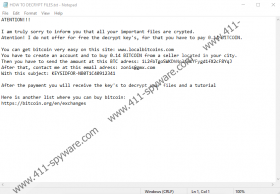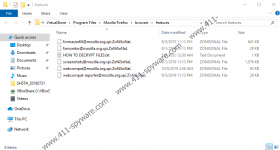ZoNiSoNaL Ransomware Removal Guide
It does not take much for malware to slither into Windows systems that lack basic security. The attackers behind ZoNiSoNaL Ransomware can use spam emails, RDP vulnerabilities, software bundles promoted on unreliable file-sharing sites, and even other infections to drop the threat. If there is no security software to warn the victim about malware or, better yet, to catch and remove it automatically, your personal files are bound to suffer. When this malicious threat slithers in, it is meant to encrypt all personal files that exist on your system, including documents that you might need to work or school and photos that might hold precious memories for you. Even if the threat only encrypts non-important files – for example, if the computer is new and does not contain personal files yet – the intrusion of malware is alarming. Do you know how to delete ZoNiSoNaL Ransomware and protect your operating system in the future?
It is easy to identify which files are corrupted by ZoNiSoNaL Ransomware because this malware attaches the “.ZoNiSoNaL” extension to their original names. Also, next to them, a file named “HOW TO DECRYPT FILES.txt” is dropped. Every affected location is meant to have a copy of this file. Even though this is a malware-related file, this one is safe to open. The message inside suggests that victims need to pay a ransom of 0.14 Bitcoin (at the time of research, this was 1,250 USD) by sending the correct amount to the attackers’ wallet (1L2fbTgoSWKDhNp3cmXYFygd1fX2cF8YqJ). The payment is supposed to guarantee that the victim obtains a decryption key that, allegedly, can restore all corrupted files. Besides paying the ransom, you are also instructed to contact the cybercriminals via zonis@gmx.com. Both paying the ransom and contacting the attackers are dangerous moves that we do not recommend making. If you choose to pay the ransom, you must expect to retrieve a decryptor, but in reality, the attackers cannot be forced to give you anything in return for your money. This is why we never recommend paying the ransom, regardless of whether you are dealing with ZoNiSoNaL Ransomware, C4H Ransomware, Qewe Ransomware, or any other threat.
If you contact the attackers behind ZoNiSoNaL Ransomware via email, you can cause even more problems for yourself. If they introduced you to the threat via email in the first place, perhaps they have been able to identify you already. However, it is also possible that cybercriminals were sending corrupted spam emails to random email addresses they found online or in exposed databases. If that is the case, by sending them a message, you reveal that a potential victim is behind the email address. The attackers might focus in on you and start making new demands. Even if you have paid the ransom, they could ask for more money, threaten to leak private data, or intimidate you in other ways. In the future, when you least expect it, they also could send you an email with another malware launcher, and you could go through the entire process all over again. But what are you supposed to do if your files were encrypted? We hope that backups exist. Whether you use online or external backups, if copies of personal files exist, you can replace the corrupted files.
Before you do anything else – and that might entail trying out free decryptors or replacing files with backup copies – you need to remove ZoNiSoNaL Ransomware. According to our researchers, the ransom note file is the only file besides the launcher that you need to eliminate. The launcher, however, could be anywhere, and its name could be misleading too. If you are unable to identify and remove this file yourself, we suggest installing anti-malware software. It can delete ZoNiSoNaL Ransomware automatically. In fact, we suggest installing this software regardless of whether or not you can erase the launcher file manually. That is because only trustworthy anti-malware software can protect you and your system against malicious threats in the future. Clearly, protection is something you need; otherwise, ransomware could not have attacked you.
How to delete ZoNiSoNaL Ransomware
- Locate the [unknown name].exe file that launched the infection.
- Right-click the malicious file and select Delete.
- Right-click and Delete every copy of the HOW TO DECRYPT FILES.txt file.
- Empty Recycle Bin to complete the removal of the ransomware.
- Install and run a trusted malware scanner to scan your system for leftovers.
ZoNiSoNaL Ransomware Screenshots:



